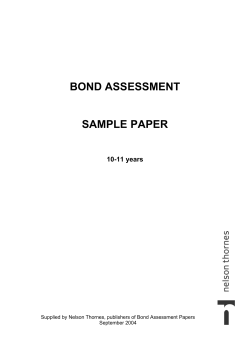
Checkerboard Cherries Web Bonus: Bolster Pillow
Page 1 of 3 November/December 2008 Checkerboard Cherries Web Bonus: Bolster Pillow Designed by Kathryn Patterson, based on the quilt by Susan Purney Mark Finished Pillow Size 18” x 42” (includes prairie points) Note: Appliqué templates are given without seam allowance. Number of Blocks and Finished Size 3 Cherry Wreath Blocks 12” x 12” Fabric Requirements Assorted black/white prints (blocks, prairie points) 3 fat quarters* total 3 assorted green textures (leaves) 12” x 12” piece each 2 assorted red textures (cherries) 8” x 9” piece each Assorted white/black prints (blocks, border, backing) 4 fat quarters* total Muslin (pillow form) 1 yd.** Pillow stuffing of choice** *A fat quarter is an 18” x 20-22” cut of fabric. **Not needed if using a purchased 14” x 38” pillow form. Cutting Instructions Planning Be sure fat quarters measure at least 18” x 20” before beginning cutting. We recommend you not wash your fat quarters prior to cutting. Instructions are included for making your own pillow form, but feel free to substitue a purchased 14” x 38” form if you prefer. Note: Cutting instructions for fat quarters are shown in Cutting Diagrams, below. Cutting instructions for green and red fabrics are on appliqué templates. Muslin 2 strips 14 1/2” x 38 1/2” Cutting Diagrams Page 2 of 3 Appliquéing the Blocks 1 Note: The appliqué background squares are cut oversized to allow for shrinkage during appliqué. Finger-press black 13” square in half on both length and width; use folds as placement guide. Referring to Diagram I, position 8 each Template A and B fabrics, keeping in mind that square will be trimmed to 12 1/2” x 12 1/2” (finished size is 12” square). Appliqué in place. Trim to 12 1/2”. Make 2 total Cherry Wreath Blocks with black backgrounds, and 1 with white background. 13˝ AB Make 2 total; trim to 12½˝ November/December 2008 Finishing 5 Stitch assorted white 10 1/2” x 14 1/2” rectangles to white 14 1/2” x 18 1/2” rectangle to make pillow back (Diagram IV). Place pillow top and back right sides together; sew 1/4” seam around all sides, leaving 8” opening for turning on 1 long side. Trim corners and turn right side out; press. 10½˝ x 14½˝ 14½˝ x 18½˝ 10½˝ x 14½˝ Make 1 total; trim to 12½˝ Diagram I Pillow Top Assembly 2 Note: Refer to Assembly Diagram for following steps. Sew 1 row of 3 blocks to make block strip. Make 1 Diagram IV 6 To make pillow form, place muslin strips right sides together and sew 1/4” seam around all sides, leaving opening for turning. Trim corners, turn right side out, and fill with pillow stuffing of your choice. Hand stitch opening closed. 1½˝ x 12½˝ 1½˝ x 38½˝ 7 Insert pillow form in finished case. Hand stitch opening closed. Assembly Diagram 3 Stitch 7 assorted white 1 1/2” x 20-22” strips together end-to-end using diagonal seams (Diagram II). Further Information 1½˝ x 20-22˝ Diagram II From pieced strip, cut borders in following lengths: 2 strips 12 1/2” each, and 2 strips 38 1/2” each. Sew 12 1/2” strips to sides of block strip. Sew 38 1/2” strips to top/bottom. 4 To make prairie point, refer to Diagram III-A and fold assorted black 4 1/2” square in half twice diagonally, wrong sides together. Press well. Make 28 total. 4½˝ fold fold Make 28 total Diagram III-A Arrange 4 along each short side and 10 along each long side of pillow top, aligning raw edges and spacing evenly (Diagram III-B). Baste a scant 1/4” from raw edges. baste Diagram III-B Susan Purney Mark and Daphne Greig own a pattern and design business called Patchworks Studio. To visit their website, go to patchworkstudio.com. Page 3 of 3 November/December 2008 Checkerboard Cherries Web Bonus: Templates Checkerboard Cherries Template A Cut 8 each 3 assorted green textures Checkerboard Cherries Template B Cut 12 each 2 assorted red textures
© Copyright 2025





















